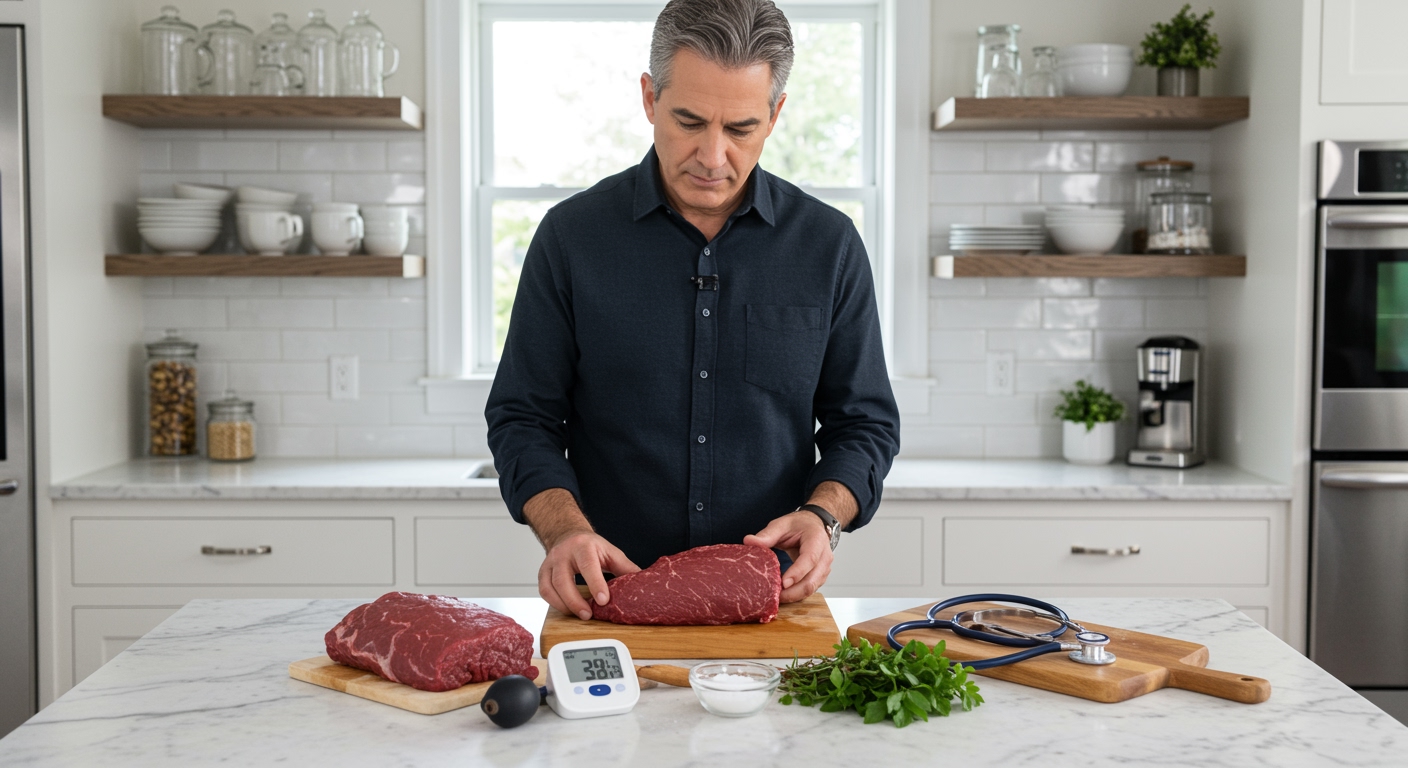✪ Key Takeaway: Bison meat is safe for hypertensive patients when consumed in proper portions due to its low sodium and high potassium content.
Introduction
Your doctor just told you to watch your blood pressure, and now you are staring at your dinner plate wondering what you can actually eat.
You might be asking this question because traditional red meat gets a bad reputation when it comes to heart health, but bison meat is different from regular beef in ways that could surprise you.
Hi, I am Abdur, your nutrition coach and today I am going to explain whether bison meat is a safe protein choice for people managing high blood pressure.
What Makes Bison Different From Regular Beef?
Bison meat contains significantly less sodium than conventional beef, which is crucial for blood pressure management.
A 3.5-ounce serving of bison contains only about 55 milligrams of sodium compared to 72 milligrams in the same amount of beef.
This difference matters because excess sodium causes your body to retain water, which increases blood volume and puts extra pressure on your arterial walls.
Bison also provides more potassium per serving than beef, delivering approximately 380 milligrams per 3.5-ounce portion.
Potassium works as a natural counterbalance to sodium by helping your kidneys excrete excess salt through urine.
The lean nature of bison meat means it contains less saturated fat, which can contribute to arterial inflammation when consumed in large amounts over time.
✪ Fact: Bison meat contains 25% less cholesterol than beef, supporting better cardiovascular health.
How Does Bison Affect Blood Pressure Directly?
The protein quality in bison meat supports healthy blood pressure through multiple mechanisms in your body.
High-quality protein helps maintain proper fluid balance by supporting albumin production in your liver, which keeps fluid in your blood vessels rather than leaking into surrounding tissues.
Bison provides all essential amino acids your body needs to produce nitric oxide, a compound that relaxes blood vessel walls and improves circulation.
The iron content in bison meat supports healthy red blood cell production, which ensures efficient oxygen transport without forcing your heart to work harder.
Unlike processed meats that contain nitrates and preservatives, grass-fed bison is typically free from these blood pressure-raising additives.
The omega-3 fatty acids naturally present in grass-fed bison help reduce inflammation in your arterial walls, promoting better blood flow and lower pressure readings.
✪ Pro Tip: Choose grass-fed bison over grain-fed varieties for maximum omega-3 benefits.
What Are The Proper Serving Sizes For Hypertensive Patients?
A safe serving size of bison meat for someone with high blood pressure is 3 to 4 ounces per meal, roughly the size of your palm.
This portion provides approximately 25 grams of high-quality protein without overwhelming your system with excessive sodium or calories.
You can safely consume bison 2 to 3 times per week as part of a balanced diet that includes plenty of vegetables and whole grains.
The key is balancing your bison intake with potassium-rich foods like leafy greens, sweet potatoes, and avocados during the same meal.
Avoid cooking methods that add extra sodium, such as heavy marinades, salt rubs, or processed seasonings that can negate the natural benefits of bison meat.
Instead, use herbs and spices like garlic, rosemary, thyme, and black pepper to enhance flavor without raising your blood pressure.
✪ Note: Always measure your portions using a food scale until you can accurately estimate serving sizes by sight.
Are There Any Risks Or Precautions To Consider?
While bison meat is generally safe for hypertensive patients, some people may need to exercise extra caution based on their individual health conditions.
If you take blood-thinning medications, consult your doctor before increasing your bison consumption, as the vitamin K content might affect your medication effectiveness.
People with kidney disease should monitor their protein intake carefully, as excessive protein can strain already compromised kidney function.
The cost factor of bison meat might lead some people to consume larger portions less frequently, but this approach can cause blood sugar spikes that indirectly affect blood pressure.
Some commercially available bison products may contain added sodium or preservatives, so always check the ingredient list before purchasing.
If you experience any unusual symptoms like digestive discomfort or changes in your blood pressure readings after eating bison, discontinue consumption and speak with your healthcare provider.
✪ Pro Tip: Keep a food diary to track how different proteins affect your blood pressure readings over time.
The Bottom Line
Bison meat is not only safe for hypertensive patients but can actually support better blood pressure management when consumed as part of a balanced diet.
The best dietary choices are those that work with your body, not against it, and bison meat provides the protein your body needs without the excessive sodium that traditional red meats often contain.
I would love to hear about your experience with bison meat or any questions you might have about incorporating it into your heart-healthy meal plan, so please share your thoughts in the comments below.
References
At NutritionCrown, we use quality and credible sources to ensure our content is accurate and trustworthy. Below are the sources referenced in creating this article:
- PMC: Nutritional and Health Benefits of Bison Meat
- Kansas Buffalo Association: Nutritional Information
- Bison Centre: Nutrient Composition of Fed Bison
- Tender Bison: Nutrition Fact: Bison is Protein Packed





